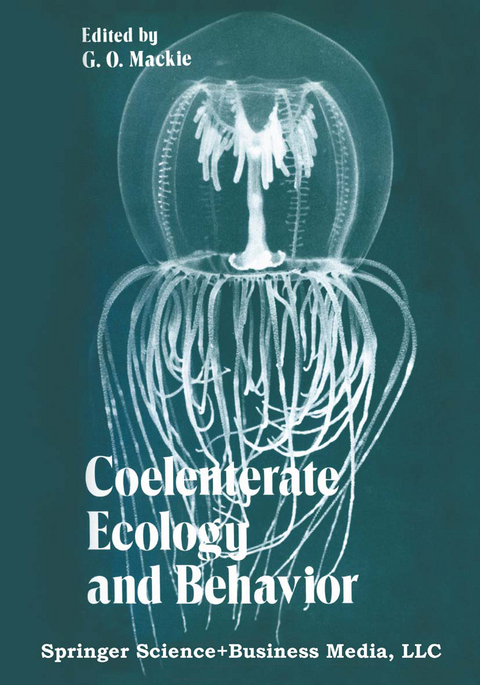
Coelenterate Ecology and Behavior
Springer-Verlag New York Inc.
978-1-4757-9726-8 (ISBN)
Water Flow in the Ecology of Benthic Cnidaria.- The Nature of Flow and the Reaction of Benthic Cnidaria to It.- Mechanical Design in Sea Anemones.- Hydroid Skeletons and Fluid Flow.- The Orientation of Aglaophenia Fans to Current in Laboratory Conditions (Hydrozoa, Coelenterata).- General Ecology of Bottom-Living Forms.- Competitive Interactions and the Species Diversity of Corals.- Habitat-Related Patterns of Productivity of the Foliaceous Reef Coral, Pavona praetorta Dana.- The Ecology of Caribbean Sea Anemones in Panama: Utilization of Space on a Coral Reef.- Growth Interactions Among Morphological Variants of the Coral Acropora palifera.- Settlement, Mortality and Recruitment of a Red Sea Scleractinian Coral Population.- Intraspecific Variability of Zooplankton Feeding in the Hermatypic Coral Montastrea cavernosa.- Accumulation of Dissolved Carbon by the Solitary Coral Balanophyllia elegans — An Alternative Nutritional Pathway?.- Regulation of Frequency of Pedal Laceration in a Sea Anemone.- The Acrorhagial Response in Anthopleura krebsi: Intraspecific and Interspecific Recognition.- Ecological Physiology and Genetics of the Colonizing Actinian Haliplanella luciae.- Nutrition Expérimentale chez les Cérianthaires.- Fouling Community Structure: Effects of the Hydroid, Obelia dichotoma, on Larval Recruitment.- The Zonation of Hydroids Along Salinity Gradients in South Carolina Estuaries.- Responses of Hydra oligactis to Temperature and Feeding Rate.- Biology of Ctenophores, Siphonophores and Medusae.- A Large-Scale Experiment on the Growth and Predation Potential of Ctenophore Populations.- Nutritional Ecology of Agalma okeni (Siphonophora: Physonectae).- Behaviour of Planktonic Coelenterates in Temperature and Salinity Discontinuity Layers.- Craspedacustasowerbii: An Analysis of an Introduced Species.- Life History of Carybdea alata Reynaud, 1830 (Cubomedusae).- Cubomedusae: Feeding — Functional Morphology, Behaviour and Phylogenetic Position.- An Edwardsiid Larva Parasitic in Mnemiopsis.- Towards a Theory of Speciation in Beroe.- Reproductive Biology.- Sea Anemone Reproduction: Patterns and Adaptive Radiations.- Reproduction of Some Common Hawaiian Reef Corals.- Reproduction, Growth and Some Tolerances of Zoanthus pacificus and Palythoa vestitus in Kaneohe Bay, Hawaii.- Characteristics of Asexual Reproduction in the Sea Anemone, Haliplanella luciae (Verrill), Reared in the Laboratory.- Some Observations on Sexual Reproduction in Tubularia.- The Structure and Function of Centriolar Satellites and Pericentriolar Processes in Cnidarian Sperm.- Early Development and Planula Movement in Haliclystus (Scyphozoa: Stauromedusae).- Larval Dispersal in the Subtidal Hydrocoral Allopora californica Verrill (1866).- Larval Adhesion, Releasing Stimuli and Metamorphosis.- Some Microenvironmental Influences on Attachment Behavior of the Planula of Cyanea capillata (Cnidaria: Scyphozoa).- A New Type of Larval Development in the Actinaria: Giant Larvae. Morphological and Ecological Aspects of Larval Development in Actinostola spetsbergensis.- Stolon vs. Hydranth Determination in Pennaria tiarella Planulae: A Role for DNA Synthesis.- SEM Studies of Strobilating Aurelia.- Associations.- The Quantitative Analysis of the Hydra-Hydramoeba Host-Parasite System.- Aspects of Light in the Biology of Green Hydra.- Survival During Starvation of Symbiotic, Aposymbiotic and Non-Symbiotic Hydra.- Sulfate Utilization in Green Hydra.- Specificity of Symbioses Between Marine Cnidarians and Zooxanthellae.- Macromolecular Mimicry: Substances Released bySea Anemones and Their Role in the Protection of Anemone Fishes.- Aposematic Coloration and Mutualism in Sponge-Dwelling Tropical Zoanthids.- Skeletal Modification by a Polychaete Annelid in Some Scleractinian Corals.- The Association of Hydractiniid Hydroids and Hermit Crabs, with New Observations from North Florida.- Functional Morphology.- Locomotion in Sea Anemones: The Pedal Disk.- Reflections on Transparency.- A Qualitative and Quantitative Inventory of Nervous Cells in Hydra attenuata Pall.- Evidence for Neural Control of Muscles in Ctenophores.- The Organization of the Neuro-Muscular System of the Diadumene Acontium.- Ultrastructure and Attachment of the Basal Disk of Haliclystus.- The Ultrastructure of the Muscle System of Stomphia coccinea.- Increase in Nematocyst and Spirocyst Discharge in a Sea Anemone in Response to Mechanical Stimulation.- A Comparison of Putative Sensory Receptors Associated with Nematocysts in an Anthozoan and a Scyphozoan.- Behavioral Physiology.- A View of the Evolution of Chemoreceptors Based on Research with Cnidarians.- Chemoreception and Conduction Systems in Sea Anemones.- Interactions Between Conducting Systems in the Sea Anemone Calliactis parasitica.- Slow Conduction in Solitary and Colonial Anthozoa.- An Electrophysiological Analysis of Behavioural Integration in Colonial Anthozoans.- Morphology and Electrophysiology of the Through-Conducting Systems in Pennatulid Coelenterates.- Probable Functions of Bioluminescence in the Pennatulacea (Cnidaria, Anthozoa).- Strategies for the Study of the Coelenterate Brain.- The Control of Fast and Slow Muscle Contractions in the Siphonophore Stem.- The Effect of Electrical Stimulation and Some Drugs on Conducting Systems of the Hydrocoral Millepora complanata.- The Reactions of Hydra attenuata Pall, to Various Photic Stimuli.- Analysis of Hydra Contraction Behaviour.- The Ultrastructural Basis for the Electrical Coordination Between Epithelia of Hydra.- Coordination of Juxtaposed Muscle Layers as Seen in Hydra.- Ionic Requirements of Transepithelial Potentials in Isolated Cell Layers of Hydra.- Electrophysiological Correlates of Feeding Behavior in Tubularia.
| Zusatzinfo | XIV, 744 p. |
|---|---|
| Verlagsort | New York, NY |
| Sprache | englisch |
| Maße | 178 x 254 mm |
| Themenwelt | Naturwissenschaften ► Biologie ► Limnologie / Meeresbiologie |
| Naturwissenschaften ► Biologie ► Ökologie / Naturschutz | |
| ISBN-10 | 1-4757-9726-5 / 1475797265 |
| ISBN-13 | 978-1-4757-9726-8 / 9781475797268 |
| Zustand | Neuware |
| Haben Sie eine Frage zum Produkt? |
aus dem Bereich


